Dissertation: Effects of Appraisals on Tesco Employees' Performance
VerifiedAdded on 2020/04/13
|56
|12520
|33
Thesis and Dissertation
AI Summary
This dissertation critically analyzes the effects of performance appraisals on employee performance, using Tesco as a case study. The research explores the concept of performance appraisal, employee performance, and various appraisal models like 360-degree appraisal and Management by Objectives. It examines the key aspects of effective performance appraisal processes, including clear objectives, flexibility, and productivity. The study delves into the issues within performance appraisal processes, such as biasness, inconsistent rating, and lack of outcome-based measures. Through thematic analysis, the dissertation identifies the performance appraisal processes used in Tesco, compares them with the UK retail sector, and assesses the issues and impact on employee performance. It also recommends improvements, including proper criteria, adequate reward and recognition, and training programs. The research concludes with limitations and suggestions for further research.
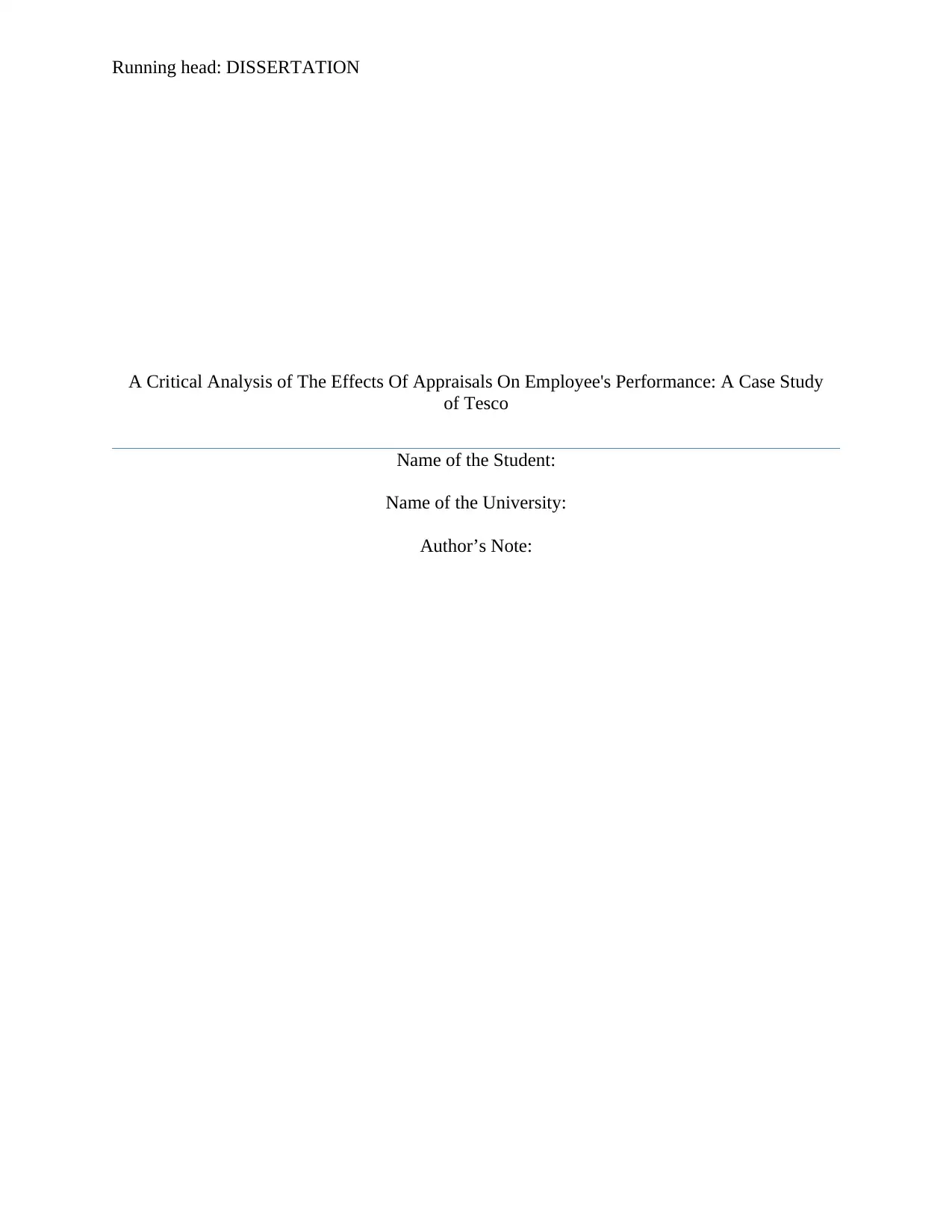
Running head: DISSERTATION
A Critical Analysis of The Effects Of Appraisals On Employee's Performance: A Case Study
of Tesco
Name of the Student:
Name of the University:
Author’s Note:
A Critical Analysis of The Effects Of Appraisals On Employee's Performance: A Case Study
of Tesco
Name of the Student:
Name of the University:
Author’s Note:
Paraphrase This Document
Need a fresh take? Get an instant paraphrase of this document with our AI Paraphraser
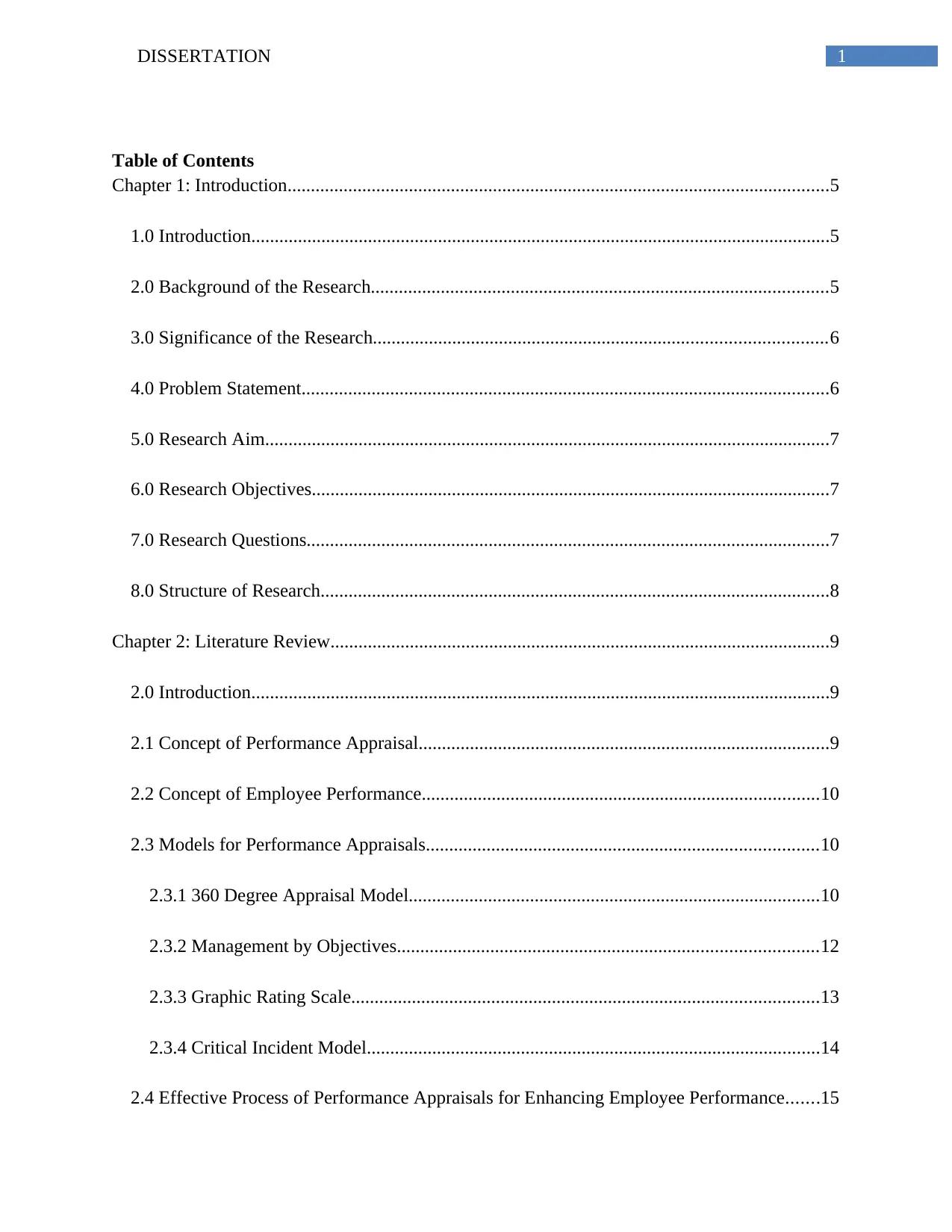
1DISSERTATION
Table of Contents
Chapter 1: Introduction....................................................................................................................5
1.0 Introduction............................................................................................................................5
2.0 Background of the Research..................................................................................................5
3.0 Significance of the Research.................................................................................................6
4.0 Problem Statement.................................................................................................................6
5.0 Research Aim.........................................................................................................................7
6.0 Research Objectives...............................................................................................................7
7.0 Research Questions................................................................................................................7
8.0 Structure of Research.............................................................................................................8
Chapter 2: Literature Review...........................................................................................................9
2.0 Introduction............................................................................................................................9
2.1 Concept of Performance Appraisal........................................................................................9
2.2 Concept of Employee Performance.....................................................................................10
2.3 Models for Performance Appraisals....................................................................................10
2.3.1 360 Degree Appraisal Model........................................................................................10
2.3.2 Management by Objectives..........................................................................................12
2.3.3 Graphic Rating Scale....................................................................................................13
2.3.4 Critical Incident Model.................................................................................................14
2.4 Effective Process of Performance Appraisals for Enhancing Employee Performance.......15
Table of Contents
Chapter 1: Introduction....................................................................................................................5
1.0 Introduction............................................................................................................................5
2.0 Background of the Research..................................................................................................5
3.0 Significance of the Research.................................................................................................6
4.0 Problem Statement.................................................................................................................6
5.0 Research Aim.........................................................................................................................7
6.0 Research Objectives...............................................................................................................7
7.0 Research Questions................................................................................................................7
8.0 Structure of Research.............................................................................................................8
Chapter 2: Literature Review...........................................................................................................9
2.0 Introduction............................................................................................................................9
2.1 Concept of Performance Appraisal........................................................................................9
2.2 Concept of Employee Performance.....................................................................................10
2.3 Models for Performance Appraisals....................................................................................10
2.3.1 360 Degree Appraisal Model........................................................................................10
2.3.2 Management by Objectives..........................................................................................12
2.3.3 Graphic Rating Scale....................................................................................................13
2.3.4 Critical Incident Model.................................................................................................14
2.4 Effective Process of Performance Appraisals for Enhancing Employee Performance.......15
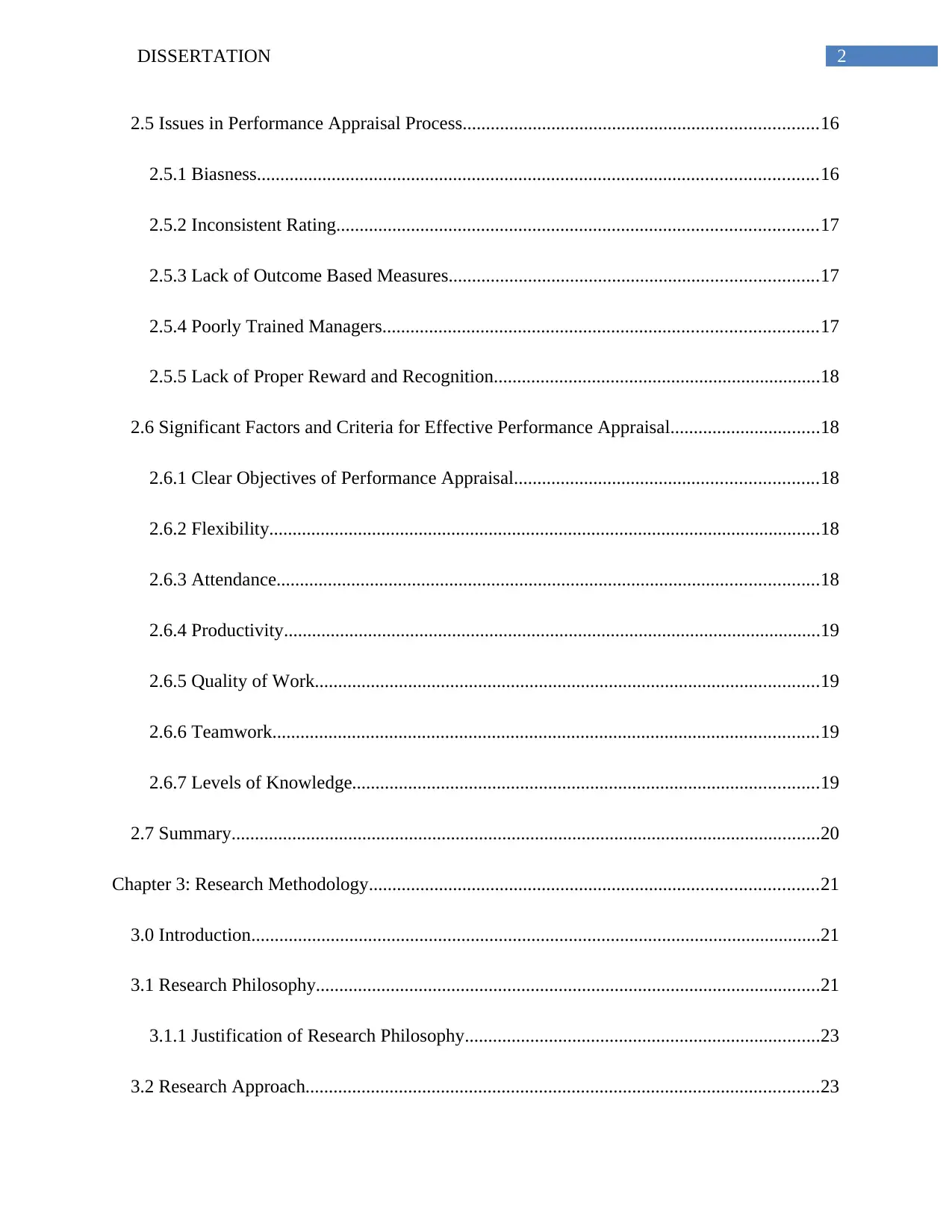
2DISSERTATION
2.5 Issues in Performance Appraisal Process............................................................................16
2.5.1 Biasness........................................................................................................................16
2.5.2 Inconsistent Rating.......................................................................................................17
2.5.3 Lack of Outcome Based Measures...............................................................................17
2.5.4 Poorly Trained Managers.............................................................................................17
2.5.5 Lack of Proper Reward and Recognition......................................................................18
2.6 Significant Factors and Criteria for Effective Performance Appraisal................................18
2.6.1 Clear Objectives of Performance Appraisal.................................................................18
2.6.2 Flexibility......................................................................................................................18
2.6.3 Attendance....................................................................................................................18
2.6.4 Productivity...................................................................................................................19
2.6.5 Quality of Work............................................................................................................19
2.6.6 Teamwork.....................................................................................................................19
2.6.7 Levels of Knowledge....................................................................................................19
2.7 Summary..............................................................................................................................20
Chapter 3: Research Methodology................................................................................................21
3.0 Introduction..........................................................................................................................21
3.1 Research Philosophy............................................................................................................21
3.1.1 Justification of Research Philosophy............................................................................23
3.2 Research Approach..............................................................................................................23
2.5 Issues in Performance Appraisal Process............................................................................16
2.5.1 Biasness........................................................................................................................16
2.5.2 Inconsistent Rating.......................................................................................................17
2.5.3 Lack of Outcome Based Measures...............................................................................17
2.5.4 Poorly Trained Managers.............................................................................................17
2.5.5 Lack of Proper Reward and Recognition......................................................................18
2.6 Significant Factors and Criteria for Effective Performance Appraisal................................18
2.6.1 Clear Objectives of Performance Appraisal.................................................................18
2.6.2 Flexibility......................................................................................................................18
2.6.3 Attendance....................................................................................................................18
2.6.4 Productivity...................................................................................................................19
2.6.5 Quality of Work............................................................................................................19
2.6.6 Teamwork.....................................................................................................................19
2.6.7 Levels of Knowledge....................................................................................................19
2.7 Summary..............................................................................................................................20
Chapter 3: Research Methodology................................................................................................21
3.0 Introduction..........................................................................................................................21
3.1 Research Philosophy............................................................................................................21
3.1.1 Justification of Research Philosophy............................................................................23
3.2 Research Approach..............................................................................................................23
⊘ This is a preview!⊘
Do you want full access?
Subscribe today to unlock all pages.

Trusted by 1+ million students worldwide
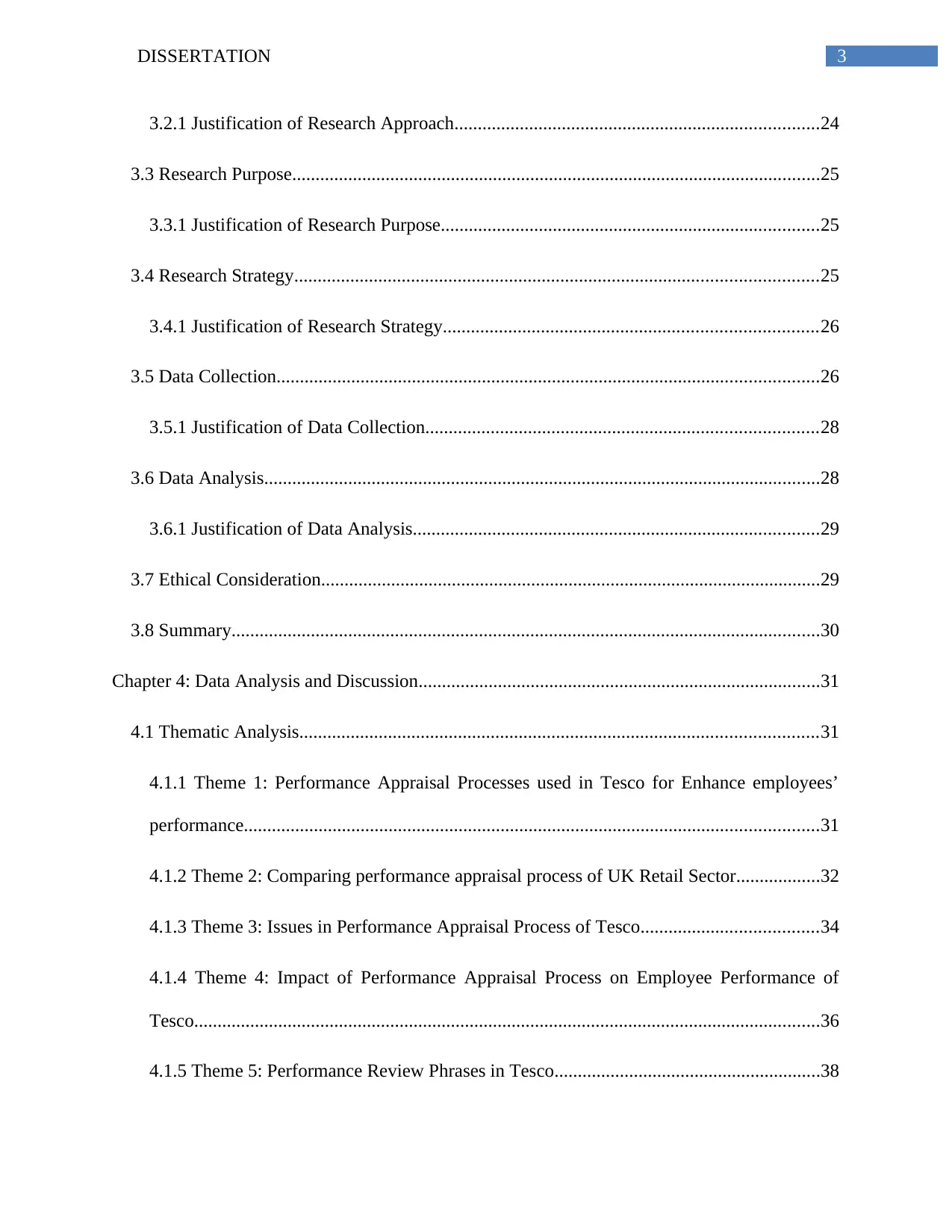
3DISSERTATION
3.2.1 Justification of Research Approach..............................................................................24
3.3 Research Purpose.................................................................................................................25
3.3.1 Justification of Research Purpose.................................................................................25
3.4 Research Strategy................................................................................................................25
3.4.1 Justification of Research Strategy................................................................................26
3.5 Data Collection....................................................................................................................26
3.5.1 Justification of Data Collection....................................................................................28
3.6 Data Analysis.......................................................................................................................28
3.6.1 Justification of Data Analysis.......................................................................................29
3.7 Ethical Consideration...........................................................................................................29
3.8 Summary..............................................................................................................................30
Chapter 4: Data Analysis and Discussion......................................................................................31
4.1 Thematic Analysis...............................................................................................................31
4.1.1 Theme 1: Performance Appraisal Processes used in Tesco for Enhance employees’
performance...........................................................................................................................31
4.1.2 Theme 2: Comparing performance appraisal process of UK Retail Sector..................32
4.1.3 Theme 3: Issues in Performance Appraisal Process of Tesco......................................34
4.1.4 Theme 4: Impact of Performance Appraisal Process on Employee Performance of
Tesco......................................................................................................................................36
4.1.5 Theme 5: Performance Review Phrases in Tesco.........................................................38
3.2.1 Justification of Research Approach..............................................................................24
3.3 Research Purpose.................................................................................................................25
3.3.1 Justification of Research Purpose.................................................................................25
3.4 Research Strategy................................................................................................................25
3.4.1 Justification of Research Strategy................................................................................26
3.5 Data Collection....................................................................................................................26
3.5.1 Justification of Data Collection....................................................................................28
3.6 Data Analysis.......................................................................................................................28
3.6.1 Justification of Data Analysis.......................................................................................29
3.7 Ethical Consideration...........................................................................................................29
3.8 Summary..............................................................................................................................30
Chapter 4: Data Analysis and Discussion......................................................................................31
4.1 Thematic Analysis...............................................................................................................31
4.1.1 Theme 1: Performance Appraisal Processes used in Tesco for Enhance employees’
performance...........................................................................................................................31
4.1.2 Theme 2: Comparing performance appraisal process of UK Retail Sector..................32
4.1.3 Theme 3: Issues in Performance Appraisal Process of Tesco......................................34
4.1.4 Theme 4: Impact of Performance Appraisal Process on Employee Performance of
Tesco......................................................................................................................................36
4.1.5 Theme 5: Performance Review Phrases in Tesco.........................................................38
Paraphrase This Document
Need a fresh take? Get an instant paraphrase of this document with our AI Paraphraser
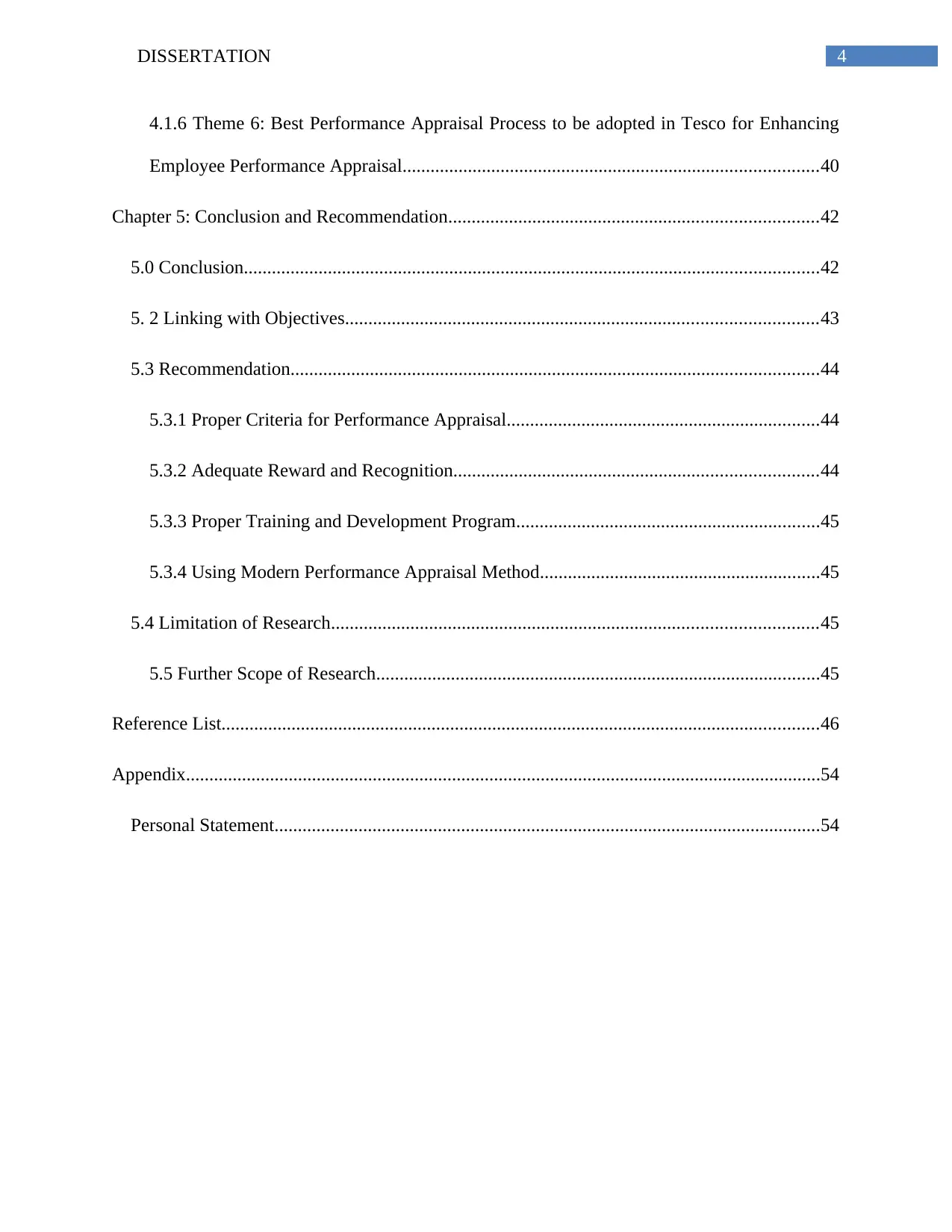
4DISSERTATION
4.1.6 Theme 6: Best Performance Appraisal Process to be adopted in Tesco for Enhancing
Employee Performance Appraisal.........................................................................................40
Chapter 5: Conclusion and Recommendation...............................................................................42
5.0 Conclusion...........................................................................................................................42
5. 2 Linking with Objectives.....................................................................................................43
5.3 Recommendation.................................................................................................................44
5.3.1 Proper Criteria for Performance Appraisal...................................................................44
5.3.2 Adequate Reward and Recognition..............................................................................44
5.3.3 Proper Training and Development Program.................................................................45
5.3.4 Using Modern Performance Appraisal Method............................................................45
5.4 Limitation of Research........................................................................................................45
5.5 Further Scope of Research...............................................................................................45
Reference List................................................................................................................................46
Appendix........................................................................................................................................54
Personal Statement.....................................................................................................................54
4.1.6 Theme 6: Best Performance Appraisal Process to be adopted in Tesco for Enhancing
Employee Performance Appraisal.........................................................................................40
Chapter 5: Conclusion and Recommendation...............................................................................42
5.0 Conclusion...........................................................................................................................42
5. 2 Linking with Objectives.....................................................................................................43
5.3 Recommendation.................................................................................................................44
5.3.1 Proper Criteria for Performance Appraisal...................................................................44
5.3.2 Adequate Reward and Recognition..............................................................................44
5.3.3 Proper Training and Development Program.................................................................45
5.3.4 Using Modern Performance Appraisal Method............................................................45
5.4 Limitation of Research........................................................................................................45
5.5 Further Scope of Research...............................................................................................45
Reference List................................................................................................................................46
Appendix........................................................................................................................................54
Personal Statement.....................................................................................................................54
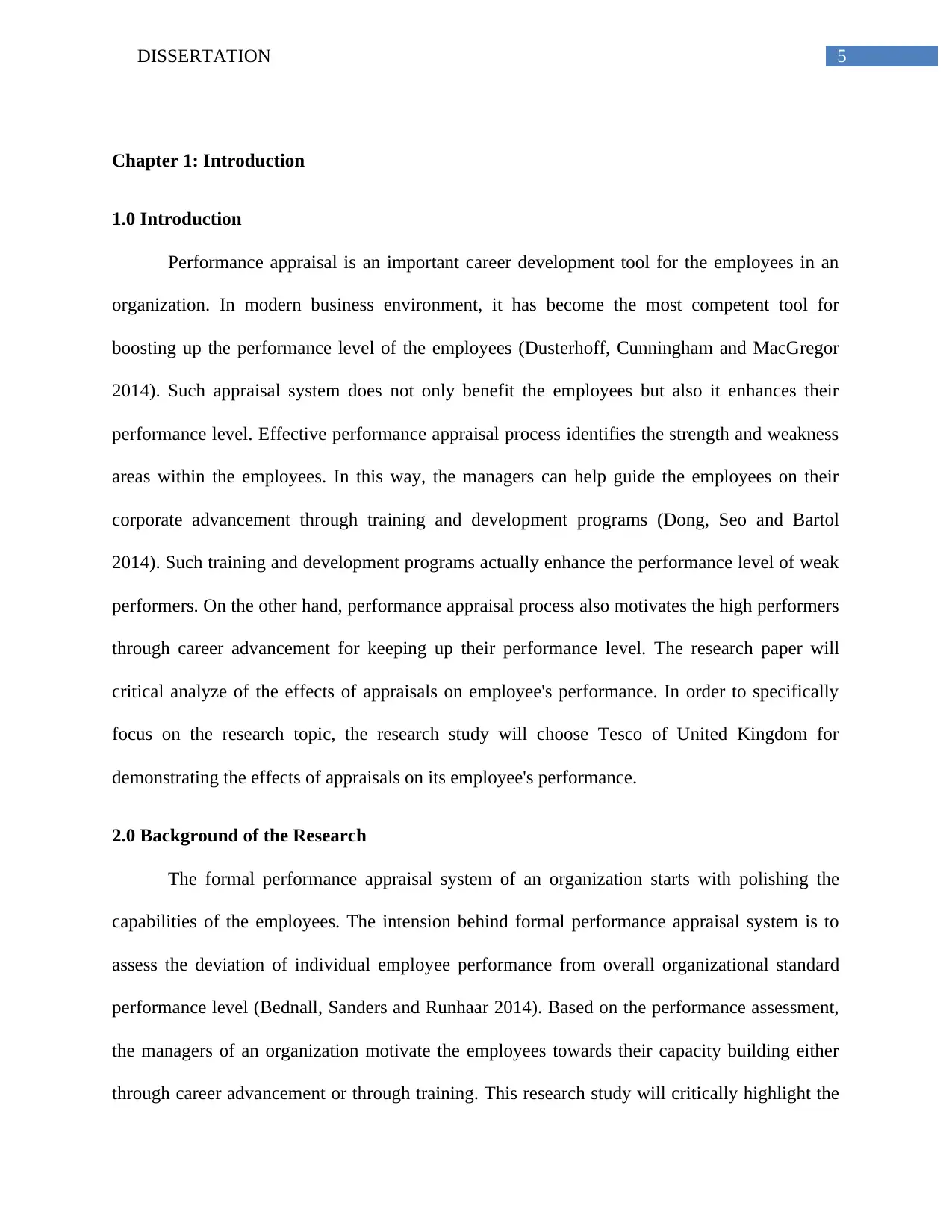
5DISSERTATION
Chapter 1: Introduction
1.0 Introduction
Performance appraisal is an important career development tool for the employees in an
organization. In modern business environment, it has become the most competent tool for
boosting up the performance level of the employees (Dusterhoff, Cunningham and MacGregor
2014). Such appraisal system does not only benefit the employees but also it enhances their
performance level. Effective performance appraisal process identifies the strength and weakness
areas within the employees. In this way, the managers can help guide the employees on their
corporate advancement through training and development programs (Dong, Seo and Bartol
2014). Such training and development programs actually enhance the performance level of weak
performers. On the other hand, performance appraisal process also motivates the high performers
through career advancement for keeping up their performance level. The research paper will
critical analyze of the effects of appraisals on employee's performance. In order to specifically
focus on the research topic, the research study will choose Tesco of United Kingdom for
demonstrating the effects of appraisals on its employee's performance.
2.0 Background of the Research
The formal performance appraisal system of an organization starts with polishing the
capabilities of the employees. The intension behind formal performance appraisal system is to
assess the deviation of individual employee performance from overall organizational standard
performance level (Bednall, Sanders and Runhaar 2014). Based on the performance assessment,
the managers of an organization motivate the employees towards their capacity building either
through career advancement or through training. This research study will critically highlight the
Chapter 1: Introduction
1.0 Introduction
Performance appraisal is an important career development tool for the employees in an
organization. In modern business environment, it has become the most competent tool for
boosting up the performance level of the employees (Dusterhoff, Cunningham and MacGregor
2014). Such appraisal system does not only benefit the employees but also it enhances their
performance level. Effective performance appraisal process identifies the strength and weakness
areas within the employees. In this way, the managers can help guide the employees on their
corporate advancement through training and development programs (Dong, Seo and Bartol
2014). Such training and development programs actually enhance the performance level of weak
performers. On the other hand, performance appraisal process also motivates the high performers
through career advancement for keeping up their performance level. The research paper will
critical analyze of the effects of appraisals on employee's performance. In order to specifically
focus on the research topic, the research study will choose Tesco of United Kingdom for
demonstrating the effects of appraisals on its employee's performance.
2.0 Background of the Research
The formal performance appraisal system of an organization starts with polishing the
capabilities of the employees. The intension behind formal performance appraisal system is to
assess the deviation of individual employee performance from overall organizational standard
performance level (Bednall, Sanders and Runhaar 2014). Based on the performance assessment,
the managers of an organization motivate the employees towards their capacity building either
through career advancement or through training. This research study will critically highlight the
⊘ This is a preview!⊘
Do you want full access?
Subscribe today to unlock all pages.

Trusted by 1+ million students worldwide
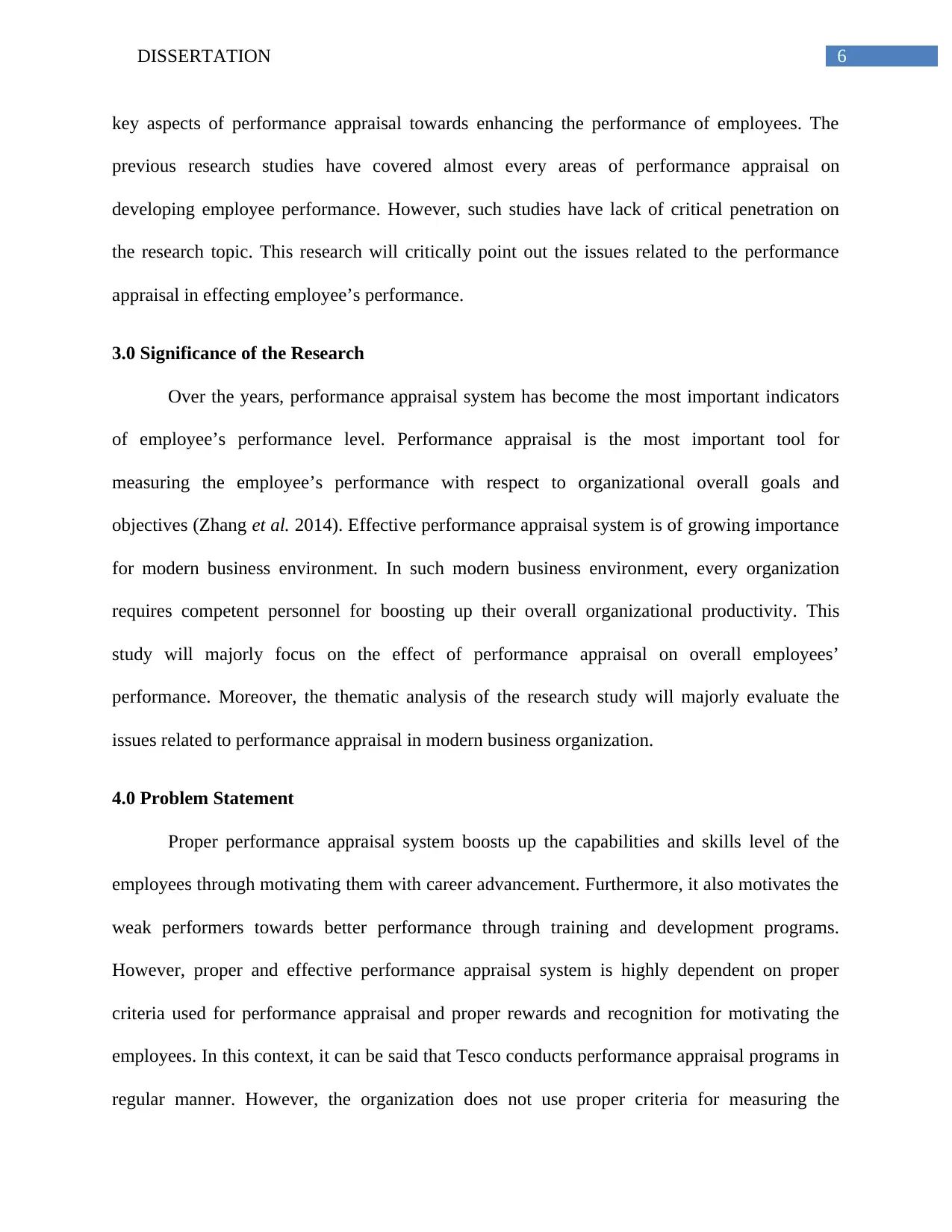
6DISSERTATION
key aspects of performance appraisal towards enhancing the performance of employees. The
previous research studies have covered almost every areas of performance appraisal on
developing employee performance. However, such studies have lack of critical penetration on
the research topic. This research will critically point out the issues related to the performance
appraisal in effecting employee’s performance.
3.0 Significance of the Research
Over the years, performance appraisal system has become the most important indicators
of employee’s performance level. Performance appraisal is the most important tool for
measuring the employee’s performance with respect to organizational overall goals and
objectives (Zhang et al. 2014). Effective performance appraisal system is of growing importance
for modern business environment. In such modern business environment, every organization
requires competent personnel for boosting up their overall organizational productivity. This
study will majorly focus on the effect of performance appraisal on overall employees’
performance. Moreover, the thematic analysis of the research study will majorly evaluate the
issues related to performance appraisal in modern business organization.
4.0 Problem Statement
Proper performance appraisal system boosts up the capabilities and skills level of the
employees through motivating them with career advancement. Furthermore, it also motivates the
weak performers towards better performance through training and development programs.
However, proper and effective performance appraisal system is highly dependent on proper
criteria used for performance appraisal and proper rewards and recognition for motivating the
employees. In this context, it can be said that Tesco conducts performance appraisal programs in
regular manner. However, the organization does not use proper criteria for measuring the
key aspects of performance appraisal towards enhancing the performance of employees. The
previous research studies have covered almost every areas of performance appraisal on
developing employee performance. However, such studies have lack of critical penetration on
the research topic. This research will critically point out the issues related to the performance
appraisal in effecting employee’s performance.
3.0 Significance of the Research
Over the years, performance appraisal system has become the most important indicators
of employee’s performance level. Performance appraisal is the most important tool for
measuring the employee’s performance with respect to organizational overall goals and
objectives (Zhang et al. 2014). Effective performance appraisal system is of growing importance
for modern business environment. In such modern business environment, every organization
requires competent personnel for boosting up their overall organizational productivity. This
study will majorly focus on the effect of performance appraisal on overall employees’
performance. Moreover, the thematic analysis of the research study will majorly evaluate the
issues related to performance appraisal in modern business organization.
4.0 Problem Statement
Proper performance appraisal system boosts up the capabilities and skills level of the
employees through motivating them with career advancement. Furthermore, it also motivates the
weak performers towards better performance through training and development programs.
However, proper and effective performance appraisal system is highly dependent on proper
criteria used for performance appraisal and proper rewards and recognition for motivating the
employees. In this context, it can be said that Tesco conducts performance appraisal programs in
regular manner. However, the organization does not use proper criteria for measuring the
Paraphrase This Document
Need a fresh take? Get an instant paraphrase of this document with our AI Paraphraser
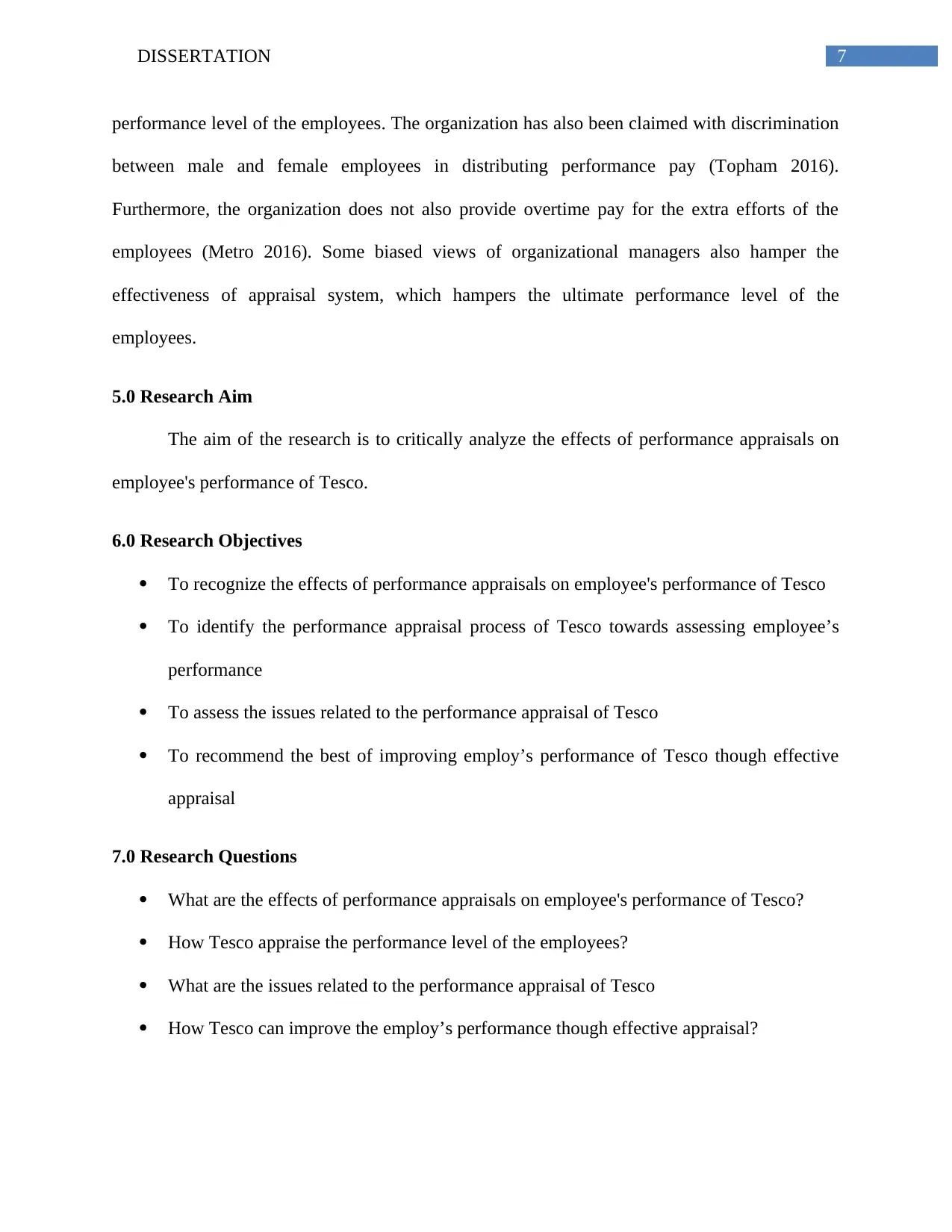
7DISSERTATION
performance level of the employees. The organization has also been claimed with discrimination
between male and female employees in distributing performance pay (Topham 2016).
Furthermore, the organization does not also provide overtime pay for the extra efforts of the
employees (Metro 2016). Some biased views of organizational managers also hamper the
effectiveness of appraisal system, which hampers the ultimate performance level of the
employees.
5.0 Research Aim
The aim of the research is to critically analyze the effects of performance appraisals on
employee's performance of Tesco.
6.0 Research Objectives
To recognize the effects of performance appraisals on employee's performance of Tesco
To identify the performance appraisal process of Tesco towards assessing employee’s
performance
To assess the issues related to the performance appraisal of Tesco
To recommend the best of improving employ’s performance of Tesco though effective
appraisal
7.0 Research Questions
What are the effects of performance appraisals on employee's performance of Tesco?
How Tesco appraise the performance level of the employees?
What are the issues related to the performance appraisal of Tesco
How Tesco can improve the employ’s performance though effective appraisal?
performance level of the employees. The organization has also been claimed with discrimination
between male and female employees in distributing performance pay (Topham 2016).
Furthermore, the organization does not also provide overtime pay for the extra efforts of the
employees (Metro 2016). Some biased views of organizational managers also hamper the
effectiveness of appraisal system, which hampers the ultimate performance level of the
employees.
5.0 Research Aim
The aim of the research is to critically analyze the effects of performance appraisals on
employee's performance of Tesco.
6.0 Research Objectives
To recognize the effects of performance appraisals on employee's performance of Tesco
To identify the performance appraisal process of Tesco towards assessing employee’s
performance
To assess the issues related to the performance appraisal of Tesco
To recommend the best of improving employ’s performance of Tesco though effective
appraisal
7.0 Research Questions
What are the effects of performance appraisals on employee's performance of Tesco?
How Tesco appraise the performance level of the employees?
What are the issues related to the performance appraisal of Tesco
How Tesco can improve the employ’s performance though effective appraisal?
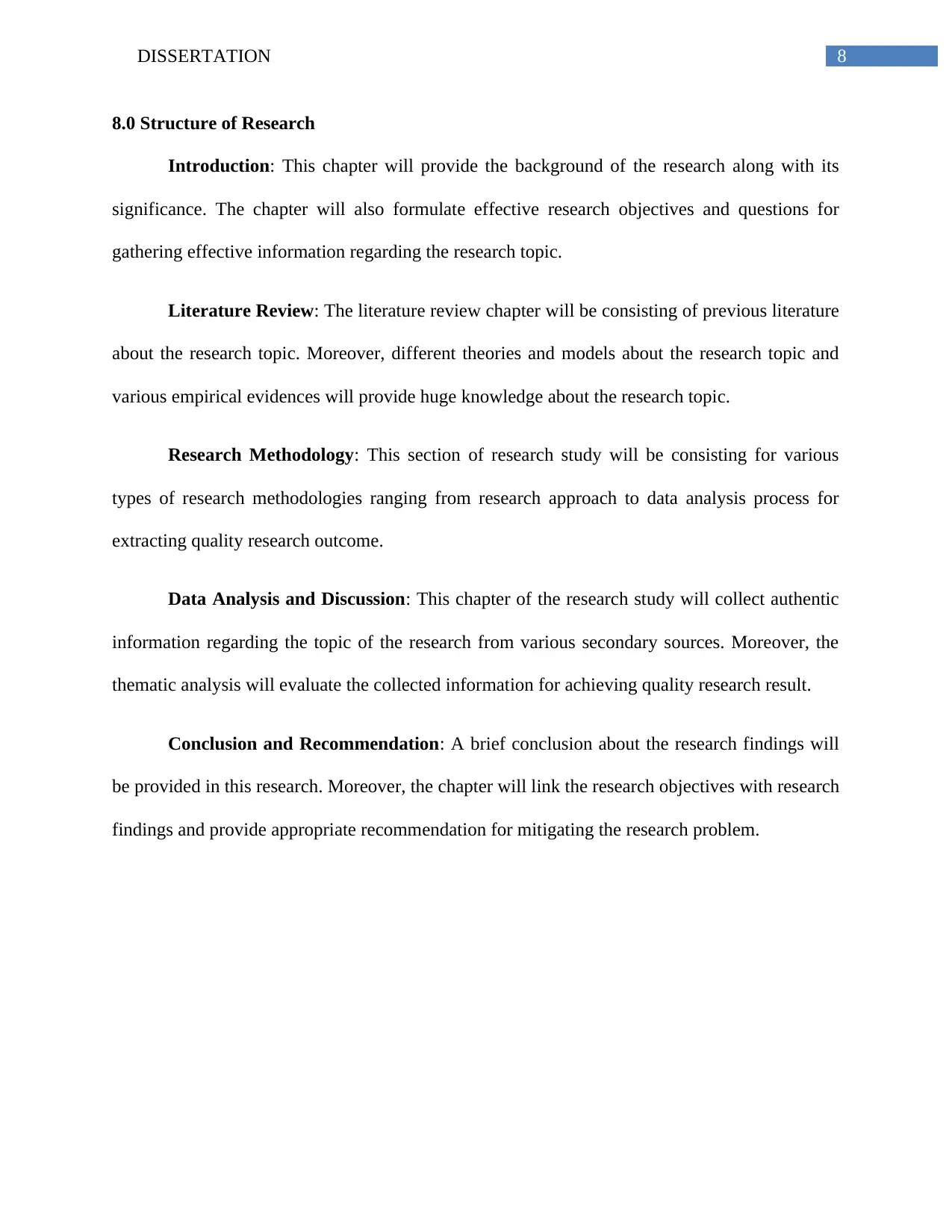
8DISSERTATION
8.0 Structure of Research
Introduction: This chapter will provide the background of the research along with its
significance. The chapter will also formulate effective research objectives and questions for
gathering effective information regarding the research topic.
Literature Review: The literature review chapter will be consisting of previous literature
about the research topic. Moreover, different theories and models about the research topic and
various empirical evidences will provide huge knowledge about the research topic.
Research Methodology: This section of research study will be consisting for various
types of research methodologies ranging from research approach to data analysis process for
extracting quality research outcome.
Data Analysis and Discussion: This chapter of the research study will collect authentic
information regarding the topic of the research from various secondary sources. Moreover, the
thematic analysis will evaluate the collected information for achieving quality research result.
Conclusion and Recommendation: A brief conclusion about the research findings will
be provided in this research. Moreover, the chapter will link the research objectives with research
findings and provide appropriate recommendation for mitigating the research problem.
8.0 Structure of Research
Introduction: This chapter will provide the background of the research along with its
significance. The chapter will also formulate effective research objectives and questions for
gathering effective information regarding the research topic.
Literature Review: The literature review chapter will be consisting of previous literature
about the research topic. Moreover, different theories and models about the research topic and
various empirical evidences will provide huge knowledge about the research topic.
Research Methodology: This section of research study will be consisting for various
types of research methodologies ranging from research approach to data analysis process for
extracting quality research outcome.
Data Analysis and Discussion: This chapter of the research study will collect authentic
information regarding the topic of the research from various secondary sources. Moreover, the
thematic analysis will evaluate the collected information for achieving quality research result.
Conclusion and Recommendation: A brief conclusion about the research findings will
be provided in this research. Moreover, the chapter will link the research objectives with research
findings and provide appropriate recommendation for mitigating the research problem.
⊘ This is a preview!⊘
Do you want full access?
Subscribe today to unlock all pages.

Trusted by 1+ million students worldwide
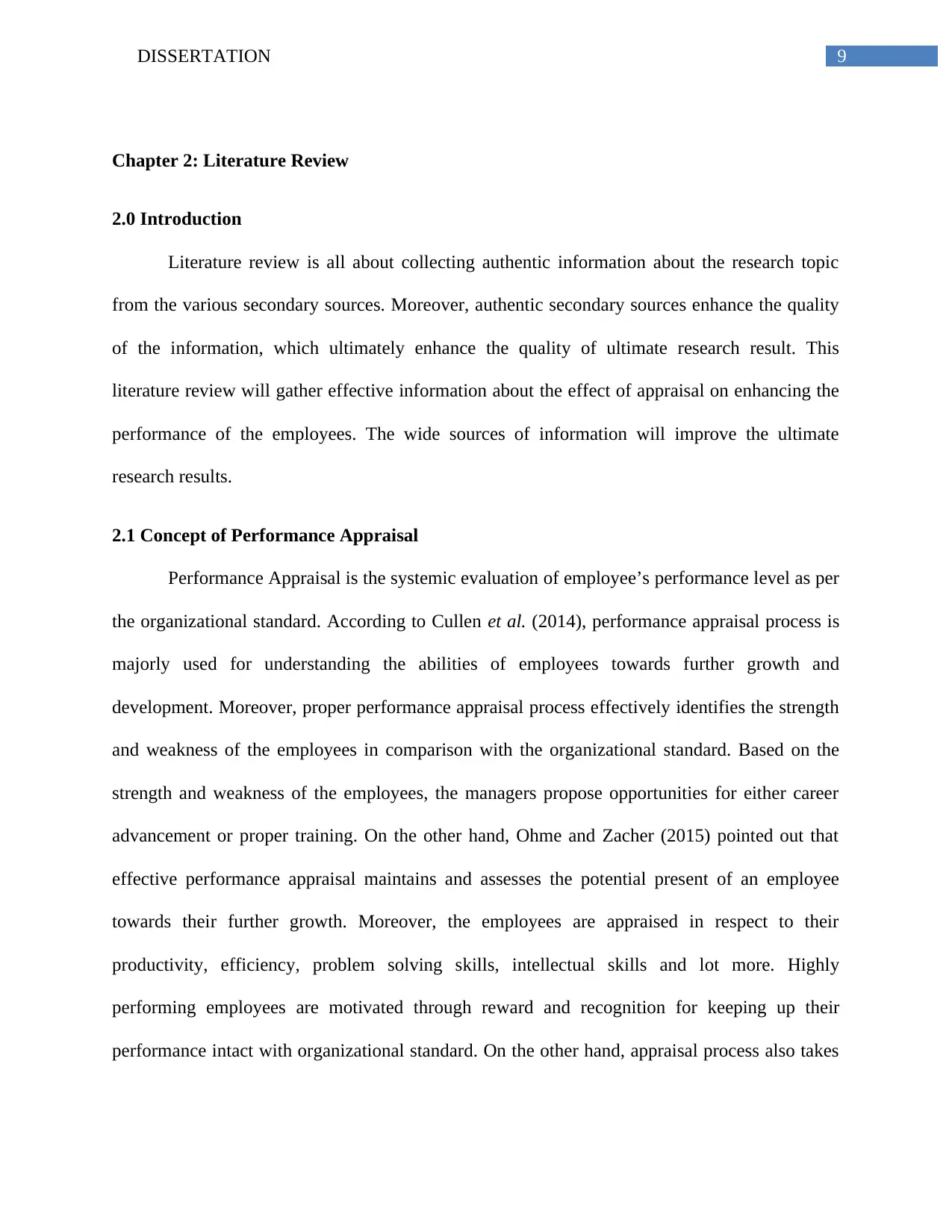
9DISSERTATION
Chapter 2: Literature Review
2.0 Introduction
Literature review is all about collecting authentic information about the research topic
from the various secondary sources. Moreover, authentic secondary sources enhance the quality
of the information, which ultimately enhance the quality of ultimate research result. This
literature review will gather effective information about the effect of appraisal on enhancing the
performance of the employees. The wide sources of information will improve the ultimate
research results.
2.1 Concept of Performance Appraisal
Performance Appraisal is the systemic evaluation of employee’s performance level as per
the organizational standard. According to Cullen et al. (2014), performance appraisal process is
majorly used for understanding the abilities of employees towards further growth and
development. Moreover, proper performance appraisal process effectively identifies the strength
and weakness of the employees in comparison with the organizational standard. Based on the
strength and weakness of the employees, the managers propose opportunities for either career
advancement or proper training. On the other hand, Ohme and Zacher (2015) pointed out that
effective performance appraisal maintains and assesses the potential present of an employee
towards their further growth. Moreover, the employees are appraised in respect to their
productivity, efficiency, problem solving skills, intellectual skills and lot more. Highly
performing employees are motivated through reward and recognition for keeping up their
performance intact with organizational standard. On the other hand, appraisal process also takes
Chapter 2: Literature Review
2.0 Introduction
Literature review is all about collecting authentic information about the research topic
from the various secondary sources. Moreover, authentic secondary sources enhance the quality
of the information, which ultimately enhance the quality of ultimate research result. This
literature review will gather effective information about the effect of appraisal on enhancing the
performance of the employees. The wide sources of information will improve the ultimate
research results.
2.1 Concept of Performance Appraisal
Performance Appraisal is the systemic evaluation of employee’s performance level as per
the organizational standard. According to Cullen et al. (2014), performance appraisal process is
majorly used for understanding the abilities of employees towards further growth and
development. Moreover, proper performance appraisal process effectively identifies the strength
and weakness of the employees in comparison with the organizational standard. Based on the
strength and weakness of the employees, the managers propose opportunities for either career
advancement or proper training. On the other hand, Ohme and Zacher (2015) pointed out that
effective performance appraisal maintains and assesses the potential present of an employee
towards their further growth. Moreover, the employees are appraised in respect to their
productivity, efficiency, problem solving skills, intellectual skills and lot more. Highly
performing employees are motivated through reward and recognition for keeping up their
performance intact with organizational standard. On the other hand, appraisal process also takes
Paraphrase This Document
Need a fresh take? Get an instant paraphrase of this document with our AI Paraphraser
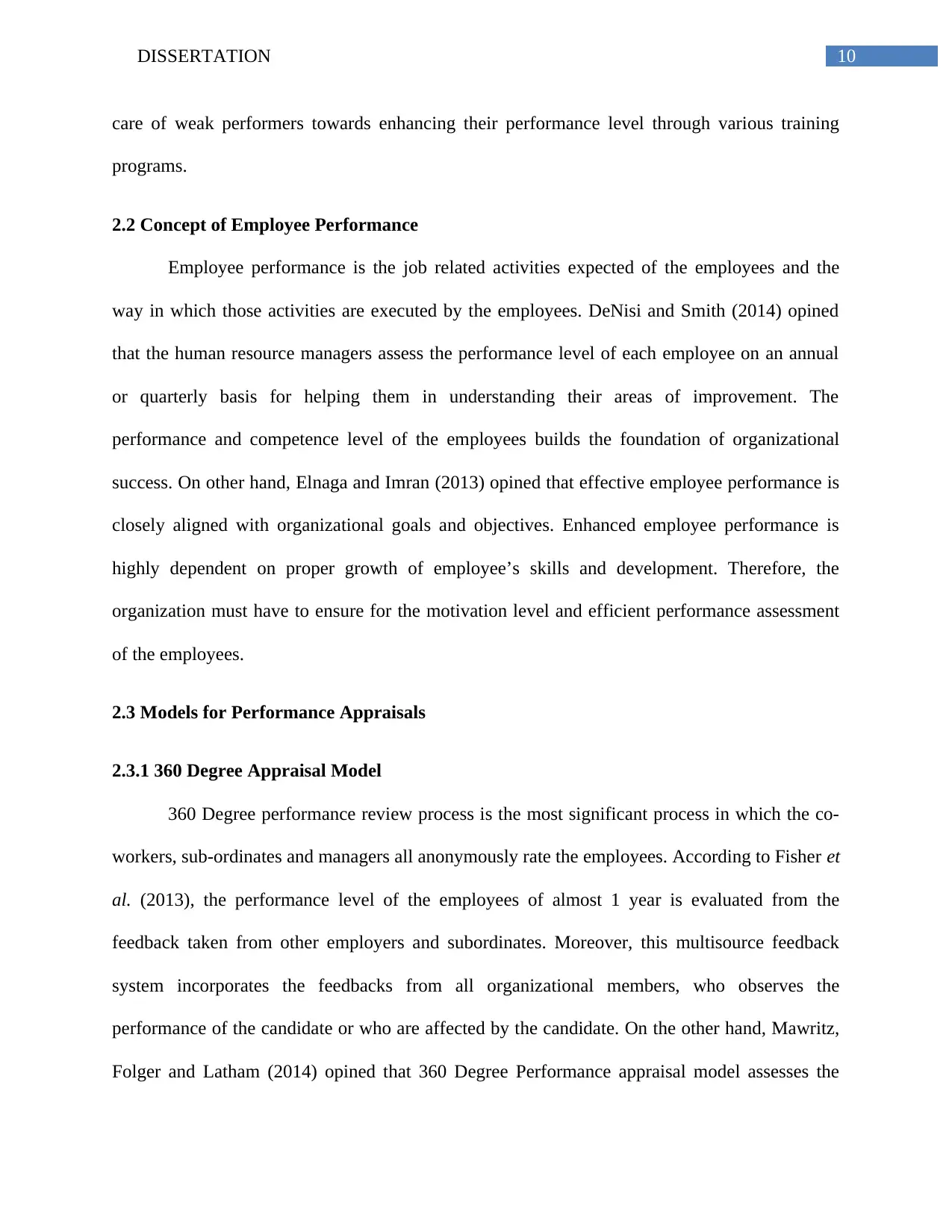
10DISSERTATION
care of weak performers towards enhancing their performance level through various training
programs.
2.2 Concept of Employee Performance
Employee performance is the job related activities expected of the employees and the
way in which those activities are executed by the employees. DeNisi and Smith (2014) opined
that the human resource managers assess the performance level of each employee on an annual
or quarterly basis for helping them in understanding their areas of improvement. The
performance and competence level of the employees builds the foundation of organizational
success. On other hand, Elnaga and Imran (2013) opined that effective employee performance is
closely aligned with organizational goals and objectives. Enhanced employee performance is
highly dependent on proper growth of employee’s skills and development. Therefore, the
organization must have to ensure for the motivation level and efficient performance assessment
of the employees.
2.3 Models for Performance Appraisals
2.3.1 360 Degree Appraisal Model
360 Degree performance review process is the most significant process in which the co-
workers, sub-ordinates and managers all anonymously rate the employees. According to Fisher et
al. (2013), the performance level of the employees of almost 1 year is evaluated from the
feedback taken from other employers and subordinates. Moreover, this multisource feedback
system incorporates the feedbacks from all organizational members, who observes the
performance of the candidate or who are affected by the candidate. On the other hand, Mawritz,
Folger and Latham (2014) opined that 360 Degree Performance appraisal model assesses the
care of weak performers towards enhancing their performance level through various training
programs.
2.2 Concept of Employee Performance
Employee performance is the job related activities expected of the employees and the
way in which those activities are executed by the employees. DeNisi and Smith (2014) opined
that the human resource managers assess the performance level of each employee on an annual
or quarterly basis for helping them in understanding their areas of improvement. The
performance and competence level of the employees builds the foundation of organizational
success. On other hand, Elnaga and Imran (2013) opined that effective employee performance is
closely aligned with organizational goals and objectives. Enhanced employee performance is
highly dependent on proper growth of employee’s skills and development. Therefore, the
organization must have to ensure for the motivation level and efficient performance assessment
of the employees.
2.3 Models for Performance Appraisals
2.3.1 360 Degree Appraisal Model
360 Degree performance review process is the most significant process in which the co-
workers, sub-ordinates and managers all anonymously rate the employees. According to Fisher et
al. (2013), the performance level of the employees of almost 1 year is evaluated from the
feedback taken from other employers and subordinates. Moreover, this multisource feedback
system incorporates the feedbacks from all organizational members, who observes the
performance of the candidate or who are affected by the candidate. On the other hand, Mawritz,
Folger and Latham (2014) opined that 360 Degree Performance appraisal model assesses the
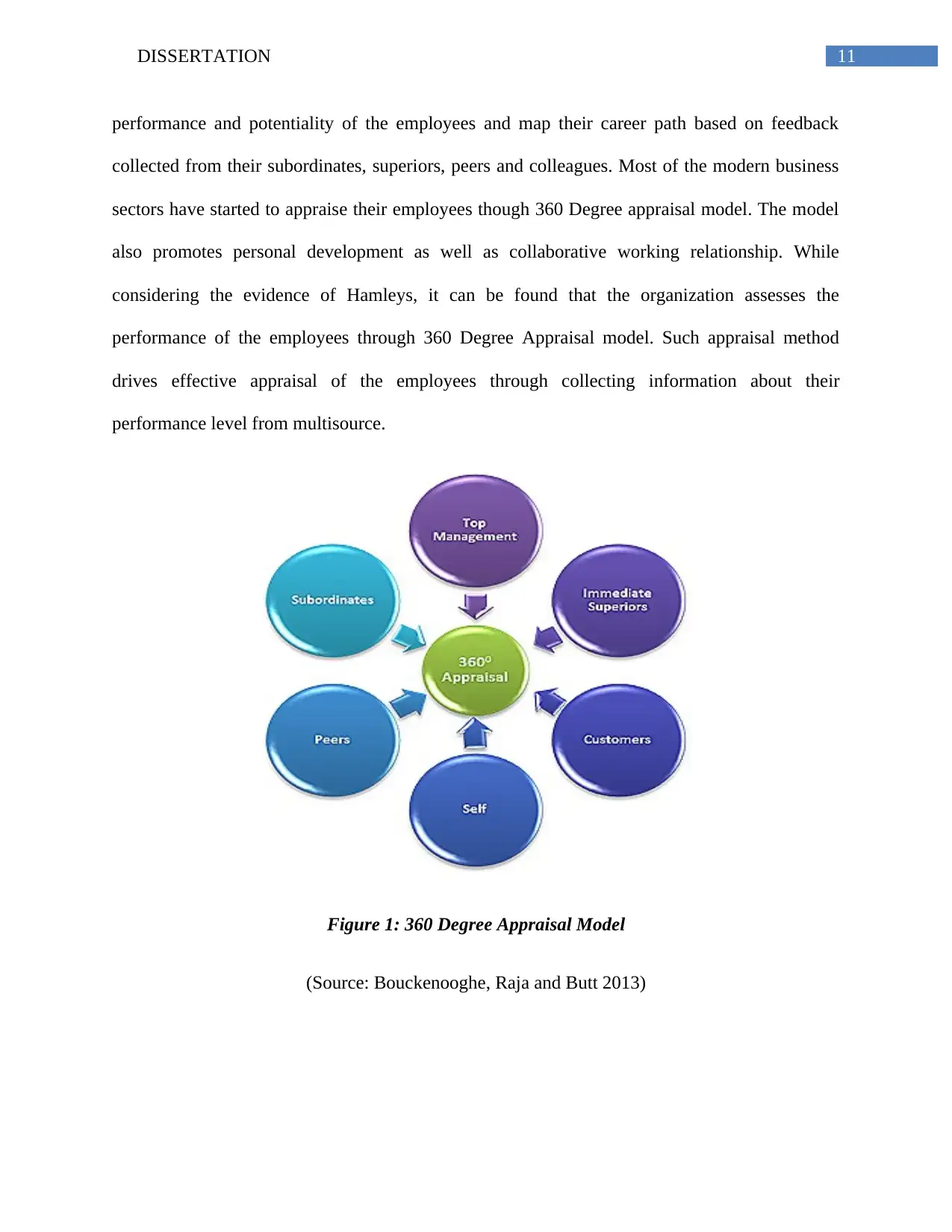
11DISSERTATION
performance and potentiality of the employees and map their career path based on feedback
collected from their subordinates, superiors, peers and colleagues. Most of the modern business
sectors have started to appraise their employees though 360 Degree appraisal model. The model
also promotes personal development as well as collaborative working relationship. While
considering the evidence of Hamleys, it can be found that the organization assesses the
performance of the employees through 360 Degree Appraisal model. Such appraisal method
drives effective appraisal of the employees through collecting information about their
performance level from multisource.
Figure 1: 360 Degree Appraisal Model
(Source: Bouckenooghe, Raja and Butt 2013)
performance and potentiality of the employees and map their career path based on feedback
collected from their subordinates, superiors, peers and colleagues. Most of the modern business
sectors have started to appraise their employees though 360 Degree appraisal model. The model
also promotes personal development as well as collaborative working relationship. While
considering the evidence of Hamleys, it can be found that the organization assesses the
performance of the employees through 360 Degree Appraisal model. Such appraisal method
drives effective appraisal of the employees through collecting information about their
performance level from multisource.
Figure 1: 360 Degree Appraisal Model
(Source: Bouckenooghe, Raja and Butt 2013)
⊘ This is a preview!⊘
Do you want full access?
Subscribe today to unlock all pages.

Trusted by 1+ million students worldwide
1 out of 56
Related Documents
Your All-in-One AI-Powered Toolkit for Academic Success.
+13062052269
info@desklib.com
Available 24*7 on WhatsApp / Email
![[object Object]](/_next/static/media/star-bottom.7253800d.svg)
Unlock your academic potential
Copyright © 2020–2025 A2Z Services. All Rights Reserved. Developed and managed by ZUCOL.





